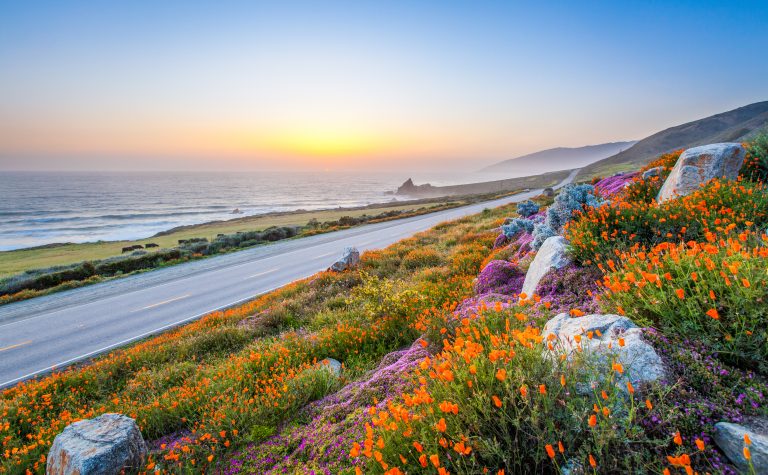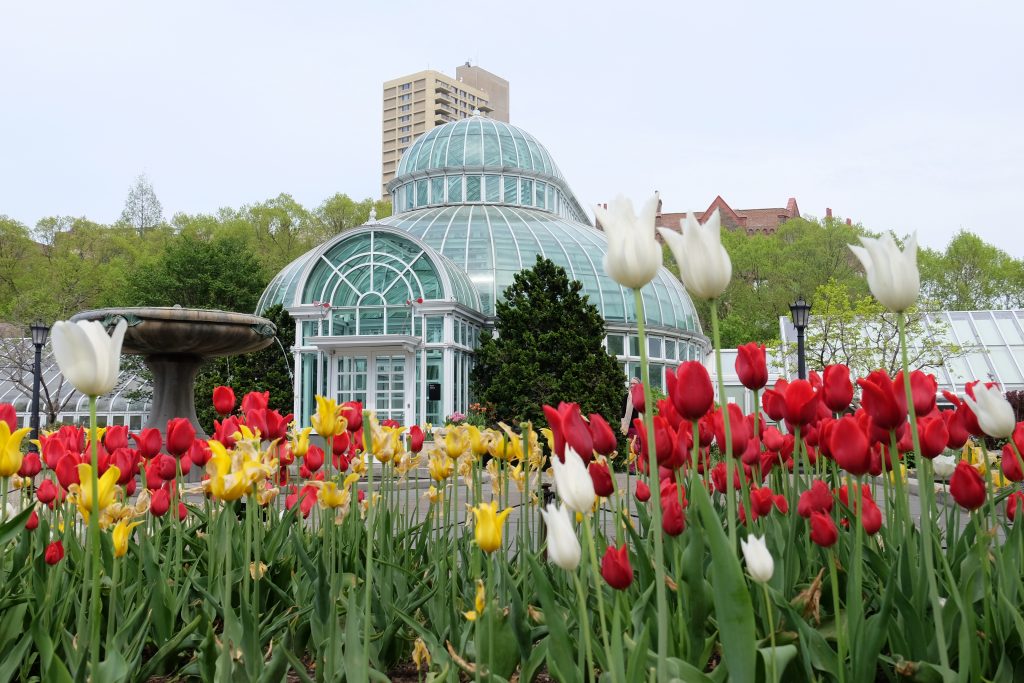Sometimes you just need to stop and smell the roses. Or touch a few palm fronds. Or take pictures of exotic plants that you’ve never seen before.
Whatever your desire, making time to visit a botanical garden or arboretum can provide you with a wealth of natural beauty — and do your health some good, too!
According to research, spending time in the natural world can reduce stress and improve your mood. And if you’ve been missing having your own “back-forty,” checking out these acres of trees, flowers and shrubs can help alleviate that longing.
With that in mind, we researched lists of top botanical gardens and arboretums in the U.S. to bring you a list of a baker’s dozen of places to visit along with a few don’t-miss highlights at each.
Wondering about the difference between an arboretum and a botanical garden? The former focuses on trees and other woody plants while the latter has all kinds of plants, from bushes to flowers to herbs. But both kinds exist for the purpose of scientific study — and to provide visitors with the chance to appreciate the beauty and diversity of nature.

1. Atlanta Botanical Garden, Atlanta, GA
Opened in 1976, this urban oasis includes 30 acres of outdoor gardens, an award-winning Children’s Garden, the serene Storza Woods highlighted by a unique Canopy Walk, and the picturesque Skyline Garden. Its sister location in Gainesville is home to the Ada Mae Pass Ivester Children’s Garden featuring hands-on exploration and opportunities for adventure.
Don’t miss the two Nationally Accredited Plant Collections™ of neotropical orchids, the 600-foot long Kendeda Canopy Walk, suspended 40 feet in the air and considered the largest tree canopy-level walkway of its kind in the United States, and the Garden’s ever-growing icon, Earth Goddess, adorned with 18,000 live annuals.
2. Brooklyn Botanic Garden, Brooklyn, NY
Although the New York State legislation reserved 39 acres for a botanic garden in 1897, it wasn’t until 1910 that the Garden was founded. Now covering 52 acres, it’s not only a place to enjoy plants but also birds and other wildlife, and specific seasonal displays. And if you’re a rose aficionado or just looking for a romantic location, make time for the Cranford Rose Garden and the Shakespeare Garden.
Don’t miss the one-acre Discovery Garden designed for children with interactive exhibits and the latest addition to the Garden: the Elizabeth Scholtz Woodland Garden opened in 2020 featuring ferns, sedges, and may-apples.
3. Chicago Botanic Garden, Glencoe, IL
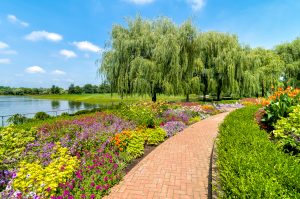
The 385-acre Chicago Botanic Garden is home to a diverse group of collections—a Bulb Garden, Circle Garden, and the Buehler Enabling Garden: a hands-on teaching garden that encourages gardening for people of all ages and abilities as well as natural areas: McDonald Woods, Dixon Prairie, and Barbara Brown Nature Reserve. But the Garden is more than just a place to view plants and flowers. It has Wellness & Fitness programs, a wide range of gardening classes, and Youth and Family programs. Tour the garden on foot or by tram.
Don’t miss the Orchid Show in February and March and the current permanent Living Collection of trees, shrubs, vines, hardy perennials, and tropical plants.
4. Dallas Arboretum and Botanical Garden, Dallas, TX
The 66-acre Dallas Arboretum has 18 Gardens with each having its own highlights as well as the Trial Gardens where ground-breaking horticultural research is conducted. It’s also home to one of the country’s premier children’s education programs at the Rory Meyers Children’s Adventure Garden and a range of events from concerts to cooking classes to the annual Food and Wine Festival.
Don’t miss A Woman’s Garden with its sculptures and infinity pool, the Margaret Elizabeth Jonsson Color Garden with more than 2,000 varieties of azaleas, and A Tasteful Place—a 3.5-acre, ornamental garden, pavilion, and kitchen where you can enjoy three free daily tastings made with seasonal produce, cooking demos, and more.
5. Denver Botanic Garden, Denver, CO
Denver Botanic Garden is known for its range of gardens and collections featuring an ever-widening diversity of plants gathered from all corners of the world. From the 18 arid gardens that are part of the Gardens of the West and the Internationally Inspired Gardens to the Ornamental Gardens, Shady Gardens, and Water Gardens, there is something for every taste and preference.
Don’t miss the Mordecai Children’s Garden—ideal if you’re traveling with a little one—and the Helen Fowler Library where you can peruse the shelves and learn more about a variety of horticultural topics.
6. Desert Botanical Garden, Phoenix, AZ
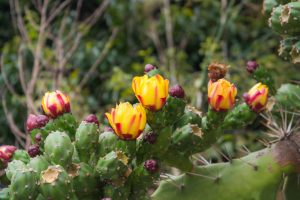
You may think that an arid environment isn’t ideal for a botanical garden, but the Desert Botanical Garden will prove you wrong. The 140 acres is home to more than 50,000 plant displays in beautiful outdoor exhibits, which include 485 rare and endangered species. Four trails take you to various parts of the Garden.
Don’t miss the 3,200 square foot open-air Butterfly Pavilion and Gertrude’s where you can dine on farm-to-table foods.
7. Fairchild Tropical Botanic Garden, Coral Gables, FL
Named Best Botanical Garden in North America by USA Today, Fairchild Tropical Botanic Garden has something for everyone, every age, and every interest. For example, the 12-acre Tropical Flowering Tree Arboretum is home to 740 species of tropical flowering trees, shrubs, and vines, collected from all tropical regions of the world, while the Jewels of the Caribbean is a unique collection of plantings that demonstrate the diversity of the Caribbean flora.
Don’t miss The Children’s Garden for kids of all ages and the Richard H. Simons Rainforest with its unique mix of species from tropical America, Africa, Asia, Australia, and the Pacific Islands.
8. Fort Worth Botanic Garden, Fort Worth, TX
The Fort Worth Botanic Garden and Botanical Research Institute of Texas is one of the largest centers for botanical exploration and discovery in the United States. The Garden features unique offerings such as the Living Collections and Art in the Garden displays, while the BRIT campus has art galleries, libraries, plant collections, and science-related exhibits—both together on a 120-acre campus.
Don’t miss the Stick Man exhibit, the Japanese Garden with its koi-filled pools, and special events such as the David Rogers’ BIG BUGS Exhibit.
9. Lewis Ginter Botanical Garden, Richmond, VA
Covering more than 50 acres, the Lewis Ginter Botanical Garden offers visitors spectacular gardens, with themed gardens including the Children’s Garden, the more than 1,500 rose bushes in the Rose Garden and the Cherry Tree Walk as well as the Kroger Community Kitchen Garden, dedicated to growing fresh produce for Feed More’s Meals on Wheels and Kids Café programs.
Don’t miss the 11,000 square-foot Conservatory with its 63-foot-tall dome—the only one of its kind in the mid-Atlantic—that houses a permanent collection of exotic and unusual plants from around the world as well as seasonal displays.
10. Longwood Gardens, Kennett Square, PA
Founded by Pierre S. du Pont, the Gardens are home to meticulously designed gardens, intricate fountain systems, and buildings of architectural grandeur. In addition to the floral displays, the Gardens is also one of the premier performing arts venues in the Philadelphia region and world-class learning opportunities for both children and adults.
Don’t miss the new Orchid House with hundreds of orchids on display and the Orangery greenhouse with its ever-changing display of flowers and foliage.
11. Missouri Botanical Garden, St. Louis, MO
The nation’s oldest botanical garden in continuous operation and a National Historic Landmark, the Missouri Botanical Garden provides visitors with 79 acres of the beautiful horticultural display as well as being a center for botanical research and science education. The Shaw Nature Reserve has 14 miles of hiking trails through a diversity of Ozark Border landscapes: floodplain forest, upland woods, dolomite glades, tallgrass prairie, oak-hickory woodlands and savannas, and wetlands.
Don’t miss the Sophia M. Sachs Butterfly House and the Climatron greenhouse: the first geodesic dome to be used as a conservatory, rising 70 feet in the center and spanning 175 feet in diameter at the base, with no interior support and no columns from floor to ceiling.
12. New York Botanical Garden, Bronx, NY
The New York Botanical Garden, a National Historic Landmark site, has a diverse array of living plant collections including the Native Plant Garden, the Perennial Garden, and the Titan-Arum (Amorphophallus Titanum) aka corpse flower, that blooms only every four to five years.
Don’t miss the Everett Children’s Adventure Garden and the Enid A. Haupt Conservatory palm dome glasshouse with galleries featuring aquatic plants and vines, lush tropical rain forests, cactus-filled deserts, and many other natural habitats.
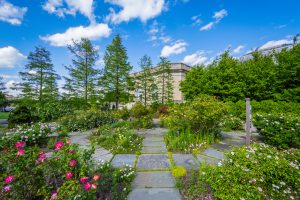
13. United States Botanic Garden, Washington, DC
The concept of the United States Botanic Garden (USBG) originated with George Washington as part of his vision for the young nation’s capital city. It was established in 1820 by the U.S. Congress, making it the oldest continuously operating botanic garden in the country. Accredited by the American Alliance of Museums, USBG has a wide array of plants and environments, including Rare and Endangered Plants Gallery and the updated Children’s Garden.
Don’t miss the newest addition, the National Garden that highlights the amazing diversity of American plants, and Bartholdi Park, a two-acre garden with exhibits displaying innovative plant combinations.
Recent Articles


